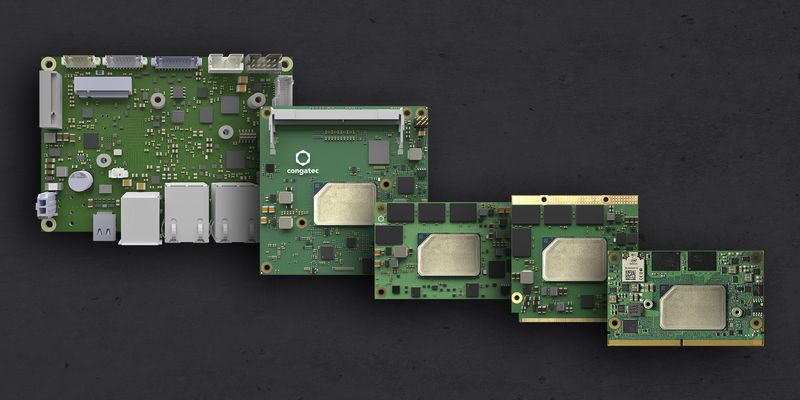Deggendorf, Germany, 23 September, 2020 * * * congatec – a leading vendor of embedded computing technology – welcomes the launch of Intel’s new low-power processor generation on five embedded form factors. To be made available on SMARC, Qseven, COM Express Compact and Mini Computer-on-Modules as well as Pico-ITX Single Board Computers (SBCs), the different Intel Atom x6000E Series processors, Intel® Celeron® and Pentium® N & J Series processors (code named “Elkhart Lake”) based on low-power 10 nm technology will pave the way for a new generation of edge-connected embedded systems. The new congatec boards and modules impress with doubled graphics performance for up to three simultaneous displays running at 4kp60 and a whopping 50% moreⁱ multi-thread computing power compared to their predecessors on up to 4 cores. Further benefits especially welcomed in real-time industrial markets are Time Sensitive Networking (TSN), Intel® Time Coordinated Computing (Intel® TCC) and Real Time Systems (RTS) hypervisor support as well as BIOS configurable ECC and extended temperature options from -40°C to +85°C.
“The combination of rugged real-time operation, real-time connectivity and real-time hypervisor technologies is what we need for IoT-connected industrial applications. Our boards and modules with the new Intel Atom, Celeron and Pentium processors deliver massive improvements in this respect for the automation and control markets, ranging from distributed process controls in smart energy grids to smart robotics, or PLCs and CNCs for discrete manufacturing. Further real-time applications can be found in test and measurement as well as in transportation such as train and wayside systems or connected autonomous vehicles,” explains Jürgen Jungbauer, Senior Product Line Manager at congatec. “Mission critical applications will also benefit from more cost-efficient ECC implementations as In-band Error Correction Code allows the use of more affordable conventional memory instead of dedicated ECC RAM.”
Additionally, the new processors are a perfect fit for any non-real-time application as it offers numerous further features and functions that are essential for today’s edge-connected embedded systems such as POS, kiosk and digital signage systems as well as distributed gaming and lottery terminals, to name just a few installations requiring remote machine-to-machine communication.
“The Internet of Things spans an array of devices, technologies, and applications, each with unique demands that often require task specific components, interfaces and even subprocessors. The Intel Atom x6000E Series and Intel Pentium and Celeron N and J Series processors combine state of the art 10nm compute and graphics technologies with a host of integrated functions and I/Os to create a single platform solution for IoT applications,” explains Jonathan Luse, Senior Director, Intel’s Industrial Solutions Division.
For this purpose, congatec’s new Intel Atom, Celeron, and Pentium processor based boards and modules include, innovative co-processor executable options for comprehensive out-of-band management plus a full range of embedded security capabilities to build consistent real trusted applications such as verified boot, measured boot, Intel® Platform Trust Technology (Intel® PTT) and Intel® Dynamic Application Loader (Intel® DAL). Supporting the Intel® Distribution of OpenVino™ toolkit and Microsoft ML, the new boards and modules will also accelerate the implementation of machine learning algorithms, e.g. for predictive maintenance.
Further technical enhancements include up to 16 GB LPDDR4x memory support with up to 4267 MT/s, PCIe Gen3 and USB 3.1 for enhanced data bandwidth as well as onboard UFS 2.1 (Universal Flash Storage). Compared to eMMC, this new storage technology has substantially higher bandwidth, faster data processing and greater storage capacities. All this is offered on the same footprint and can be used even for primary boot and storage. The full benefits of the new processors are explained in the congatec Whitepaper on congatec’s landing page www.congatec.com/Intel-Atom-x6000E.
The new boards and modules are available in Pico-ITX Single Board Computer (SBC), SMARC, Qseven, COM Express Compact and Mini form factors in the following processor configurations:
| Processor | Cores / Threads | Clock [GHz] (High Frequency Mode//Turbo/Burst) | CPU L2 Cache (MB) | GFE Execution Units | TDP (W) |
| Intel Atom® X6425E | 4 | 1.8 / 3.0 | 1.5 | 32 | 12 |
| Intel Atom® X6413E | 4 | 1.5 /3.0 | 1.5 | 16 | 9 |
| Intel Atom® X6211E | 2 | 1.2 /3.0 | 1.5 | 16 | 6 |
| Intel Atom® X6425RE | 4 | 1.9 / - | 1.5 | 32 | 12 |
| Intel Atom® X6414RE | 4 | 1.5 / - | 1.5 | 16 | 9 |
| Intel Atom® X6212RE | 2 | 1.2 / - | 1.5 | 16 | 6 |
| Intel® Pentium®J6425 | 4 | 1.8 / 3.0 | 1.5 | 32 | 10 |
| Intel® Celeron® J6413 | 4 | 1.8 / 3.0 | 1.5 | 16 | 10 |
Detailed feature sets of the different SMARC, Qseven, COM Express Compact and Mini Computer-on-Modules as well as the Pico-ITX SBC can be found in the corresponding datasheets at congatec’s landing page: www.congatec.com/Intel-Atom-x6000E
ⁱ Source: Intel. Claims based on a) SPEC CPU 2006 metric estimates based on Pre-Si projections and b) 3DMark11 estimates based on Pre-Si projections, using Intel® Pentium® J4205 as prior gen.
Configurations:
- Performance results are based on projections as of September 1st, 2020
- Processor: Intel® Pentium® J6425 PL1=10W TDP, 4C4T Turbo up to 3.0GHz
- Graphics: Intel Graphics Gen 11 gfx
- Memory: 16GB LPDDR4-3200
- OS: Windows* 10 Pro
- Compiler version: IC18
- Processor: Intel® Pentium® J4205 PL1=10W TDP, 4C4T Turbo up to 2.6GHz
- Graphics: Intel Graphics Gen 9 gfx
- Memory: 16GB LPDDR4-2400
- OS: Windows* 10 Pro
- Compiler version: IC18
Performance numbers are Pre-Si projections and are subject to change. Results reported may need to be revised as additional testing is conducted. The results depend on the specific platform configurations and workloads utilized in the testing, and may not be applicable to any particular users components, computer system or workloads. The results are not necessarily representative of other benchmarks.


